Critique of 'Risk Management Process in Projects' for GDPM 525 Course
VerifiedAdded on 2022/08/26
|7
|1328
|38
Report
AI Summary
This report presents a critical evaluation of the research article "Risk Management Process in Projects" by DOVAL (2019), conducted for a GDPM 525 assignment. The critique examines the article's purpose, literature review, theoretical framework, methodology, and findings. It assesses the significance of the research problem, the thoroughness of the literature review, and the validity of the research questions and hypotheses. The report analyzes the data collection methods, sampling techniques, and the overall design of the study, including its strengths and limitations. The analysis also covers the representation of the findings, the author's conclusions, and suggestions for future research, highlighting the article's reliability and consistency while also pointing out areas for improvement, such as the need for critical analysis and primary data collection. The report concludes with an assessment of the article's overall contribution to the field of project risk management.
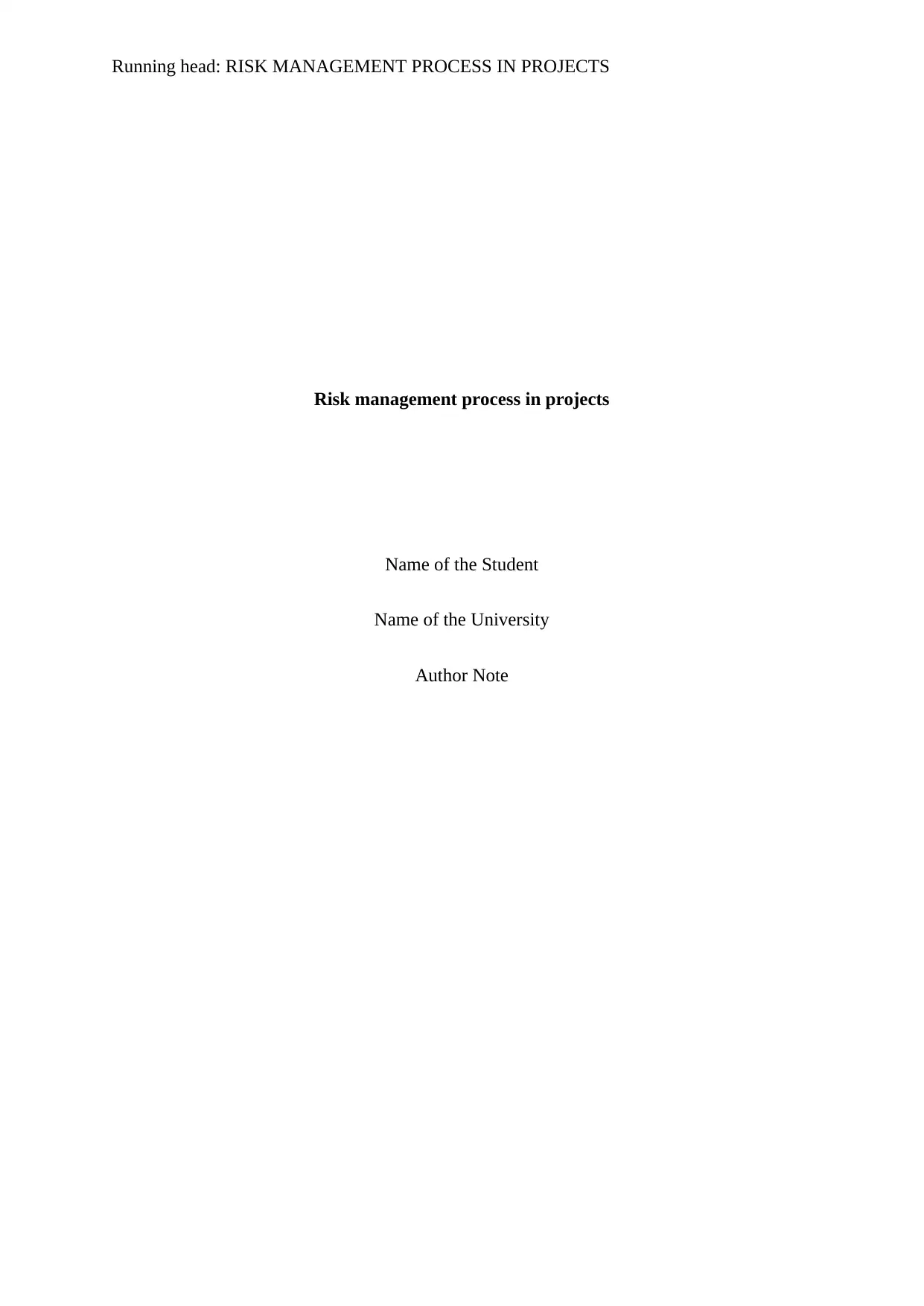
Running head: RISK MANAGEMENT PROCESS IN PROJECTS
Risk management process in projects
Name of the Student
Name of the University
Author Note
Risk management process in projects
Name of the Student
Name of the University
Author Note
Paraphrase This Document
Need a fresh take? Get an instant paraphrase of this document with our AI Paraphraser
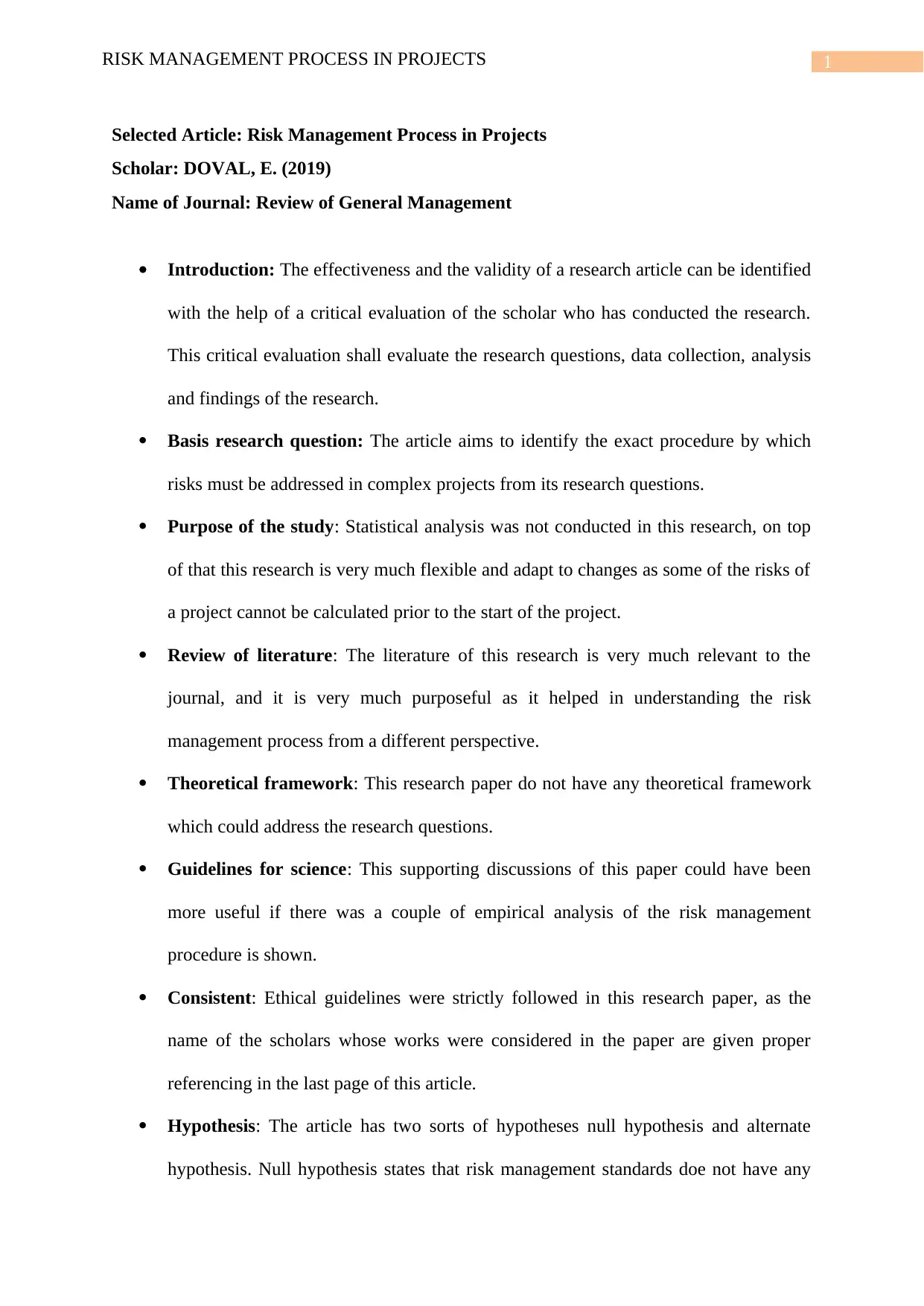
1RISK MANAGEMENT PROCESS IN PROJECTS
Selected Article: Risk Management Process in Projects
Scholar: DOVAL, E. (2019)
Name of Journal: Review of General Management
Introduction: The effectiveness and the validity of a research article can be identified
with the help of a critical evaluation of the scholar who has conducted the research.
This critical evaluation shall evaluate the research questions, data collection, analysis
and findings of the research.
Basis research question: The article aims to identify the exact procedure by which
risks must be addressed in complex projects from its research questions.
Purpose of the study: Statistical analysis was not conducted in this research, on top
of that this research is very much flexible and adapt to changes as some of the risks of
a project cannot be calculated prior to the start of the project.
Review of literature: The literature of this research is very much relevant to the
journal, and it is very much purposeful as it helped in understanding the risk
management process from a different perspective.
Theoretical framework: This research paper do not have any theoretical framework
which could address the research questions.
Guidelines for science: This supporting discussions of this paper could have been
more useful if there was a couple of empirical analysis of the risk management
procedure is shown.
Consistent: Ethical guidelines were strictly followed in this research paper, as the
name of the scholars whose works were considered in the paper are given proper
referencing in the last page of this article.
Hypothesis: The article has two sorts of hypotheses null hypothesis and alternate
hypothesis. Null hypothesis states that risk management standards doe not have any
Selected Article: Risk Management Process in Projects
Scholar: DOVAL, E. (2019)
Name of Journal: Review of General Management
Introduction: The effectiveness and the validity of a research article can be identified
with the help of a critical evaluation of the scholar who has conducted the research.
This critical evaluation shall evaluate the research questions, data collection, analysis
and findings of the research.
Basis research question: The article aims to identify the exact procedure by which
risks must be addressed in complex projects from its research questions.
Purpose of the study: Statistical analysis was not conducted in this research, on top
of that this research is very much flexible and adapt to changes as some of the risks of
a project cannot be calculated prior to the start of the project.
Review of literature: The literature of this research is very much relevant to the
journal, and it is very much purposeful as it helped in understanding the risk
management process from a different perspective.
Theoretical framework: This research paper do not have any theoretical framework
which could address the research questions.
Guidelines for science: This supporting discussions of this paper could have been
more useful if there was a couple of empirical analysis of the risk management
procedure is shown.
Consistent: Ethical guidelines were strictly followed in this research paper, as the
name of the scholars whose works were considered in the paper are given proper
referencing in the last page of this article.
Hypothesis: The article has two sorts of hypotheses null hypothesis and alternate
hypothesis. Null hypothesis states that risk management standards doe not have any
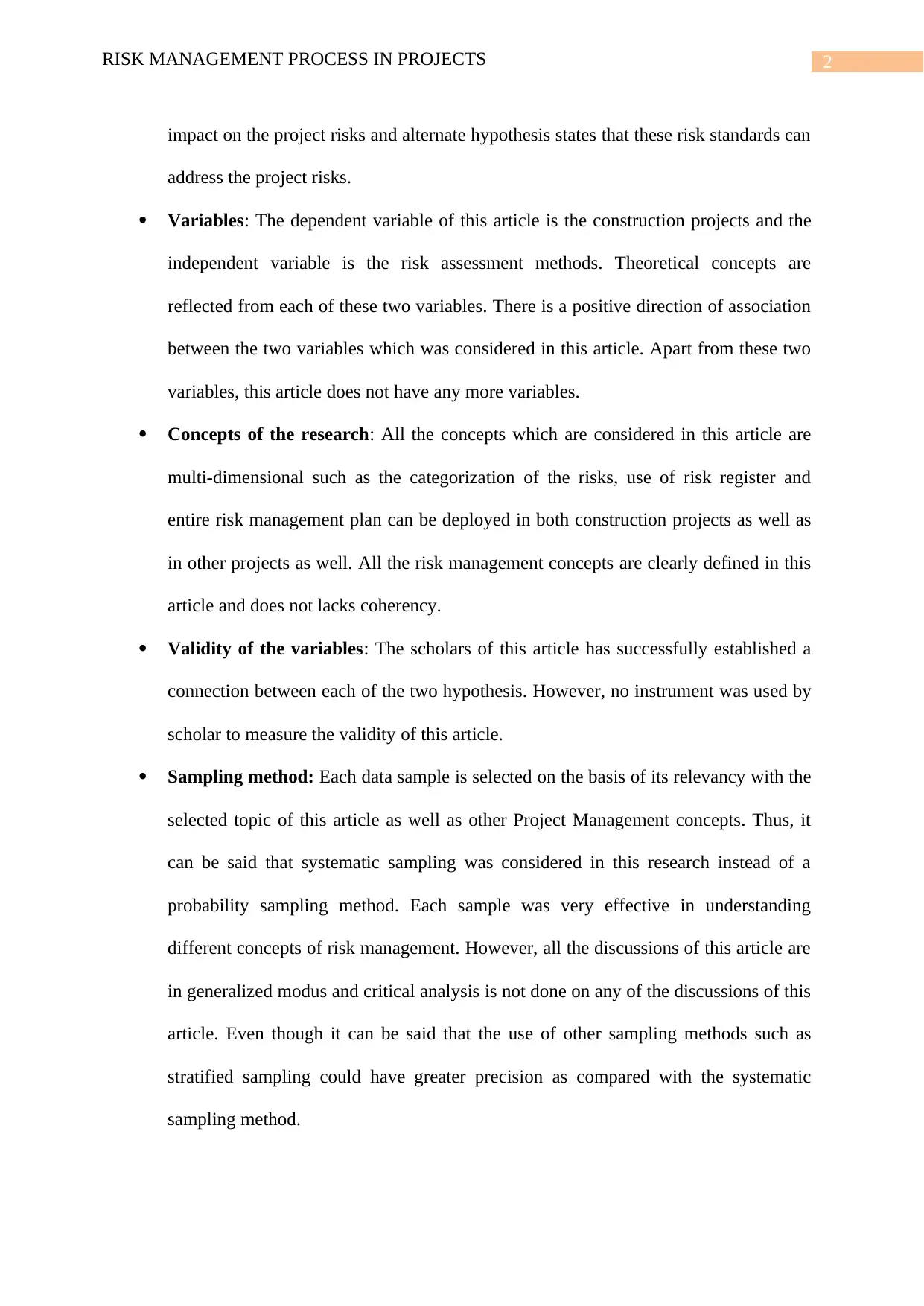
2RISK MANAGEMENT PROCESS IN PROJECTS
impact on the project risks and alternate hypothesis states that these risk standards can
address the project risks.
Variables: The dependent variable of this article is the construction projects and the
independent variable is the risk assessment methods. Theoretical concepts are
reflected from each of these two variables. There is a positive direction of association
between the two variables which was considered in this article. Apart from these two
variables, this article does not have any more variables.
Concepts of the research: All the concepts which are considered in this article are
multi-dimensional such as the categorization of the risks, use of risk register and
entire risk management plan can be deployed in both construction projects as well as
in other projects as well. All the risk management concepts are clearly defined in this
article and does not lacks coherency.
Validity of the variables: The scholars of this article has successfully established a
connection between each of the two hypothesis. However, no instrument was used by
scholar to measure the validity of this article.
Sampling method: Each data sample is selected on the basis of its relevancy with the
selected topic of this article as well as other Project Management concepts. Thus, it
can be said that systematic sampling was considered in this research instead of a
probability sampling method. Each sample was very effective in understanding
different concepts of risk management. However, all the discussions of this article are
in generalized modus and critical analysis is not done on any of the discussions of this
article. Even though it can be said that the use of other sampling methods such as
stratified sampling could have greater precision as compared with the systematic
sampling method.
impact on the project risks and alternate hypothesis states that these risk standards can
address the project risks.
Variables: The dependent variable of this article is the construction projects and the
independent variable is the risk assessment methods. Theoretical concepts are
reflected from each of these two variables. There is a positive direction of association
between the two variables which was considered in this article. Apart from these two
variables, this article does not have any more variables.
Concepts of the research: All the concepts which are considered in this article are
multi-dimensional such as the categorization of the risks, use of risk register and
entire risk management plan can be deployed in both construction projects as well as
in other projects as well. All the risk management concepts are clearly defined in this
article and does not lacks coherency.
Validity of the variables: The scholars of this article has successfully established a
connection between each of the two hypothesis. However, no instrument was used by
scholar to measure the validity of this article.
Sampling method: Each data sample is selected on the basis of its relevancy with the
selected topic of this article as well as other Project Management concepts. Thus, it
can be said that systematic sampling was considered in this research instead of a
probability sampling method. Each sample was very effective in understanding
different concepts of risk management. However, all the discussions of this article are
in generalized modus and critical analysis is not done on any of the discussions of this
article. Even though it can be said that the use of other sampling methods such as
stratified sampling could have greater precision as compared with the systematic
sampling method.
⊘ This is a preview!⊘
Do you want full access?
Subscribe today to unlock all pages.

Trusted by 1+ million students worldwide
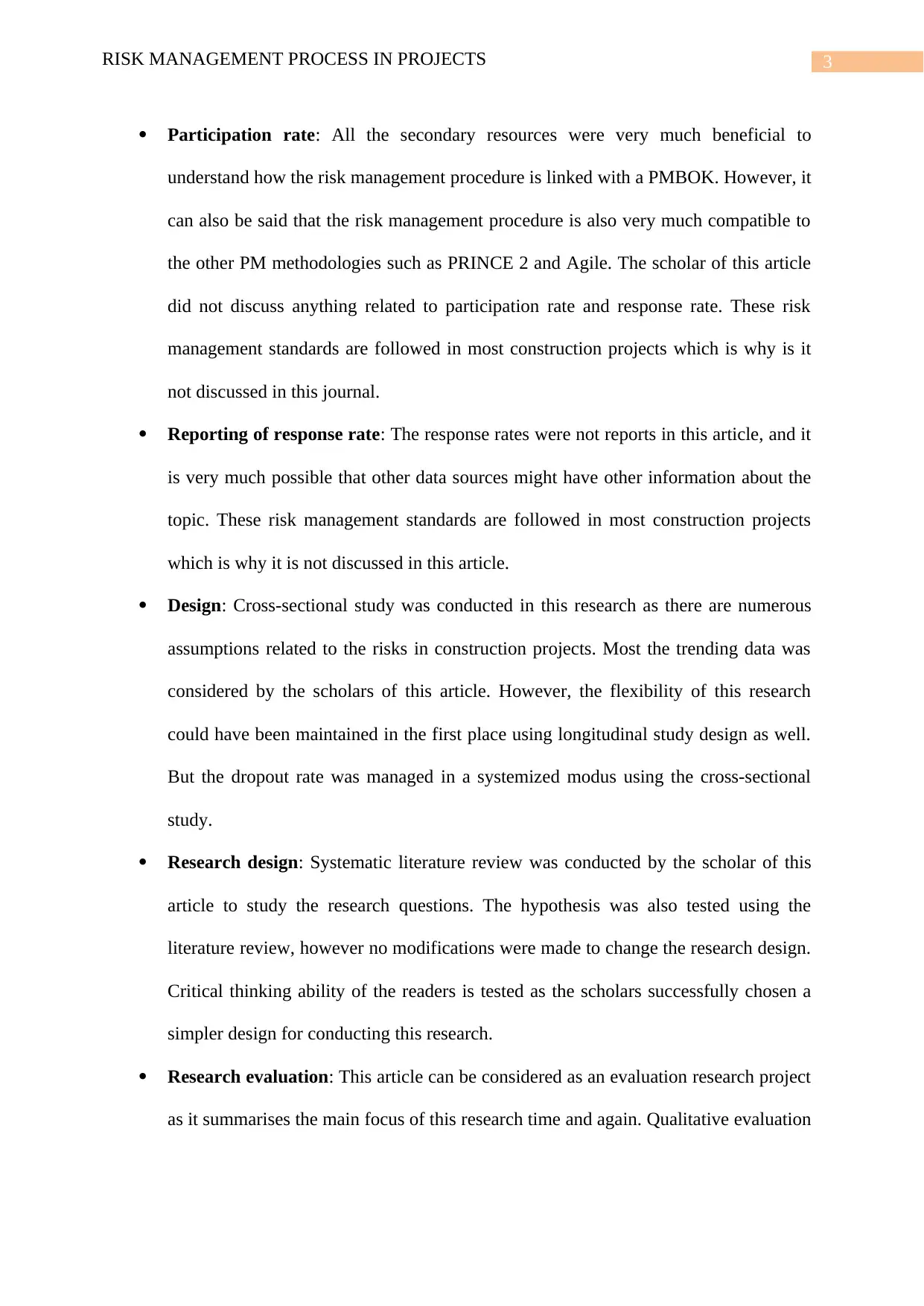
3RISK MANAGEMENT PROCESS IN PROJECTS
Participation rate: All the secondary resources were very much beneficial to
understand how the risk management procedure is linked with a PMBOK. However, it
can also be said that the risk management procedure is also very much compatible to
the other PM methodologies such as PRINCE 2 and Agile. The scholar of this article
did not discuss anything related to participation rate and response rate. These risk
management standards are followed in most construction projects which is why is it
not discussed in this journal.
Reporting of response rate: The response rates were not reports in this article, and it
is very much possible that other data sources might have other information about the
topic. These risk management standards are followed in most construction projects
which is why it is not discussed in this article.
Design: Cross-sectional study was conducted in this research as there are numerous
assumptions related to the risks in construction projects. Most the trending data was
considered by the scholars of this article. However, the flexibility of this research
could have been maintained in the first place using longitudinal study design as well.
But the dropout rate was managed in a systemized modus using the cross-sectional
study.
Research design: Systematic literature review was conducted by the scholar of this
article to study the research questions. The hypothesis was also tested using the
literature review, however no modifications were made to change the research design.
Critical thinking ability of the readers is tested as the scholars successfully chosen a
simpler design for conducting this research.
Research evaluation: This article can be considered as an evaluation research project
as it summarises the main focus of this research time and again. Qualitative evaluation
Participation rate: All the secondary resources were very much beneficial to
understand how the risk management procedure is linked with a PMBOK. However, it
can also be said that the risk management procedure is also very much compatible to
the other PM methodologies such as PRINCE 2 and Agile. The scholar of this article
did not discuss anything related to participation rate and response rate. These risk
management standards are followed in most construction projects which is why is it
not discussed in this journal.
Reporting of response rate: The response rates were not reports in this article, and it
is very much possible that other data sources might have other information about the
topic. These risk management standards are followed in most construction projects
which is why it is not discussed in this article.
Design: Cross-sectional study was conducted in this research as there are numerous
assumptions related to the risks in construction projects. Most the trending data was
considered by the scholars of this article. However, the flexibility of this research
could have been maintained in the first place using longitudinal study design as well.
But the dropout rate was managed in a systemized modus using the cross-sectional
study.
Research design: Systematic literature review was conducted by the scholar of this
article to study the research questions. The hypothesis was also tested using the
literature review, however no modifications were made to change the research design.
Critical thinking ability of the readers is tested as the scholars successfully chosen a
simpler design for conducting this research.
Research evaluation: This article can be considered as an evaluation research project
as it summarises the main focus of this research time and again. Qualitative evaluation
Paraphrase This Document
Need a fresh take? Get an instant paraphrase of this document with our AI Paraphraser
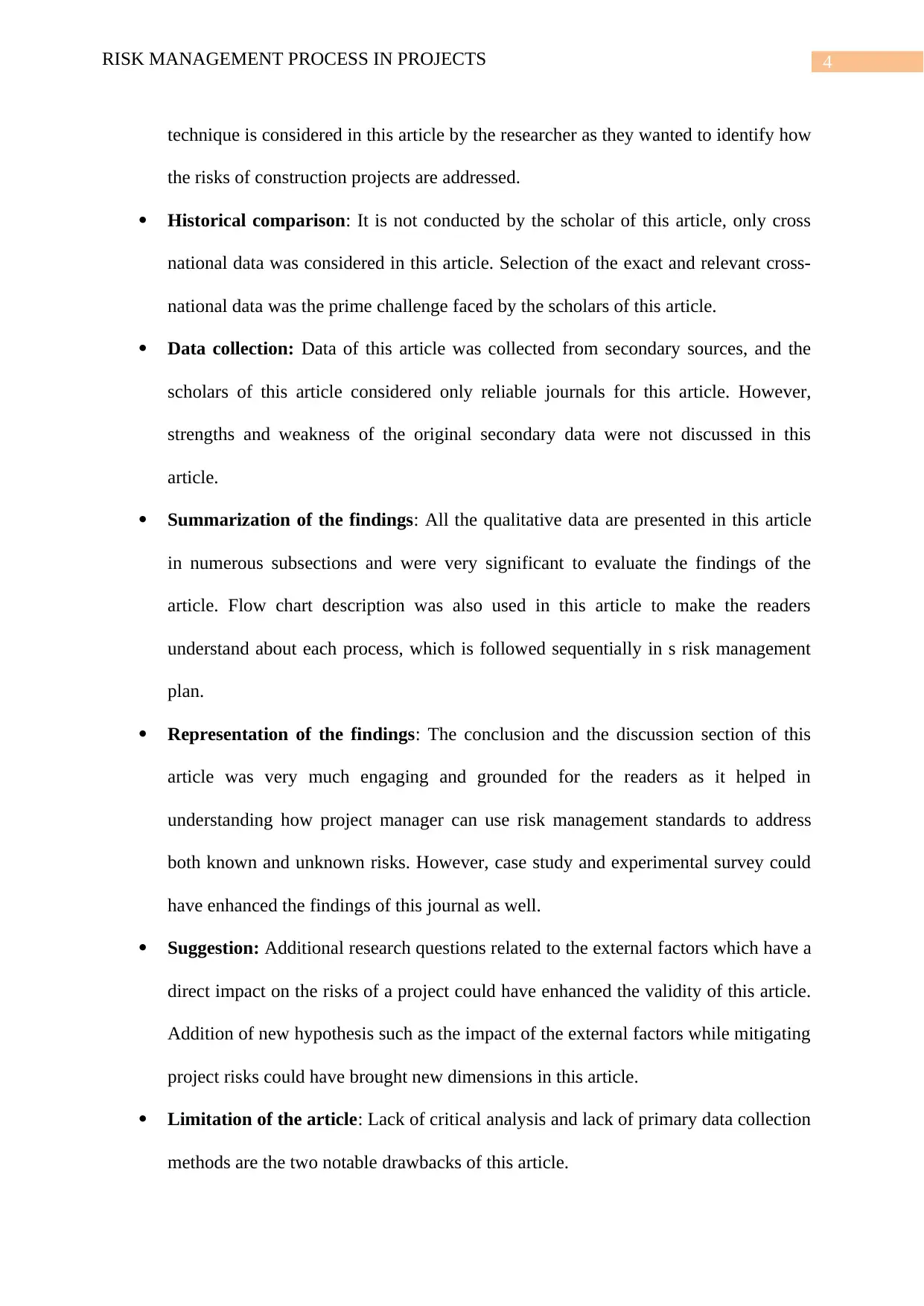
4RISK MANAGEMENT PROCESS IN PROJECTS
technique is considered in this article by the researcher as they wanted to identify how
the risks of construction projects are addressed.
Historical comparison: It is not conducted by the scholar of this article, only cross
national data was considered in this article. Selection of the exact and relevant cross-
national data was the prime challenge faced by the scholars of this article.
Data collection: Data of this article was collected from secondary sources, and the
scholars of this article considered only reliable journals for this article. However,
strengths and weakness of the original secondary data were not discussed in this
article.
Summarization of the findings: All the qualitative data are presented in this article
in numerous subsections and were very significant to evaluate the findings of the
article. Flow chart description was also used in this article to make the readers
understand about each process, which is followed sequentially in s risk management
plan.
Representation of the findings: The conclusion and the discussion section of this
article was very much engaging and grounded for the readers as it helped in
understanding how project manager can use risk management standards to address
both known and unknown risks. However, case study and experimental survey could
have enhanced the findings of this journal as well.
Suggestion: Additional research questions related to the external factors which have a
direct impact on the risks of a project could have enhanced the validity of this article.
Addition of new hypothesis such as the impact of the external factors while mitigating
project risks could have brought new dimensions in this article.
Limitation of the article: Lack of critical analysis and lack of primary data collection
methods are the two notable drawbacks of this article.
technique is considered in this article by the researcher as they wanted to identify how
the risks of construction projects are addressed.
Historical comparison: It is not conducted by the scholar of this article, only cross
national data was considered in this article. Selection of the exact and relevant cross-
national data was the prime challenge faced by the scholars of this article.
Data collection: Data of this article was collected from secondary sources, and the
scholars of this article considered only reliable journals for this article. However,
strengths and weakness of the original secondary data were not discussed in this
article.
Summarization of the findings: All the qualitative data are presented in this article
in numerous subsections and were very significant to evaluate the findings of the
article. Flow chart description was also used in this article to make the readers
understand about each process, which is followed sequentially in s risk management
plan.
Representation of the findings: The conclusion and the discussion section of this
article was very much engaging and grounded for the readers as it helped in
understanding how project manager can use risk management standards to address
both known and unknown risks. However, case study and experimental survey could
have enhanced the findings of this journal as well.
Suggestion: Additional research questions related to the external factors which have a
direct impact on the risks of a project could have enhanced the validity of this article.
Addition of new hypothesis such as the impact of the external factors while mitigating
project risks could have brought new dimensions in this article.
Limitation of the article: Lack of critical analysis and lack of primary data collection
methods are the two notable drawbacks of this article.
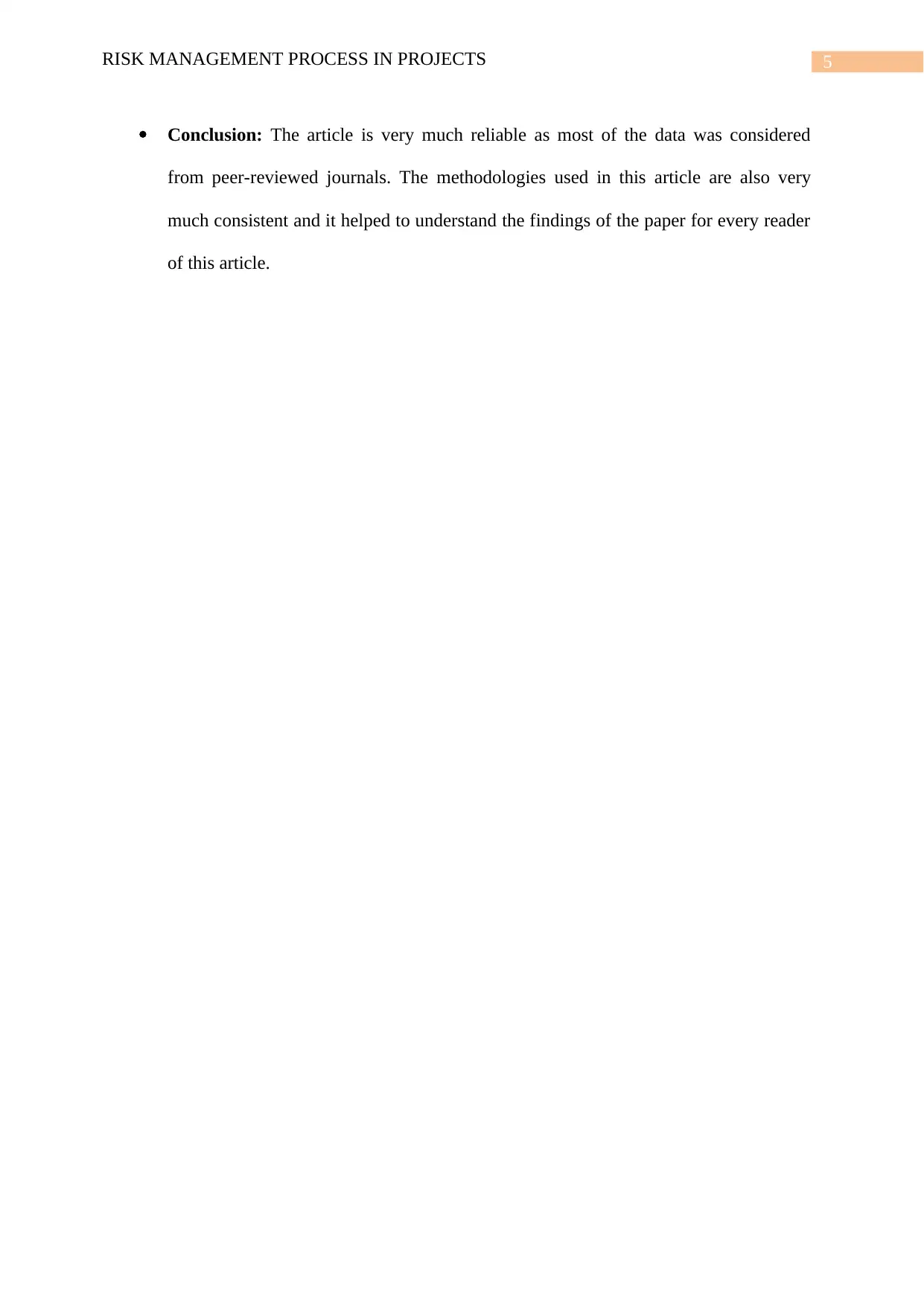
5RISK MANAGEMENT PROCESS IN PROJECTS
Conclusion: The article is very much reliable as most of the data was considered
from peer-reviewed journals. The methodologies used in this article are also very
much consistent and it helped to understand the findings of the paper for every reader
of this article.
Conclusion: The article is very much reliable as most of the data was considered
from peer-reviewed journals. The methodologies used in this article are also very
much consistent and it helped to understand the findings of the paper for every reader
of this article.
⊘ This is a preview!⊘
Do you want full access?
Subscribe today to unlock all pages.

Trusted by 1+ million students worldwide
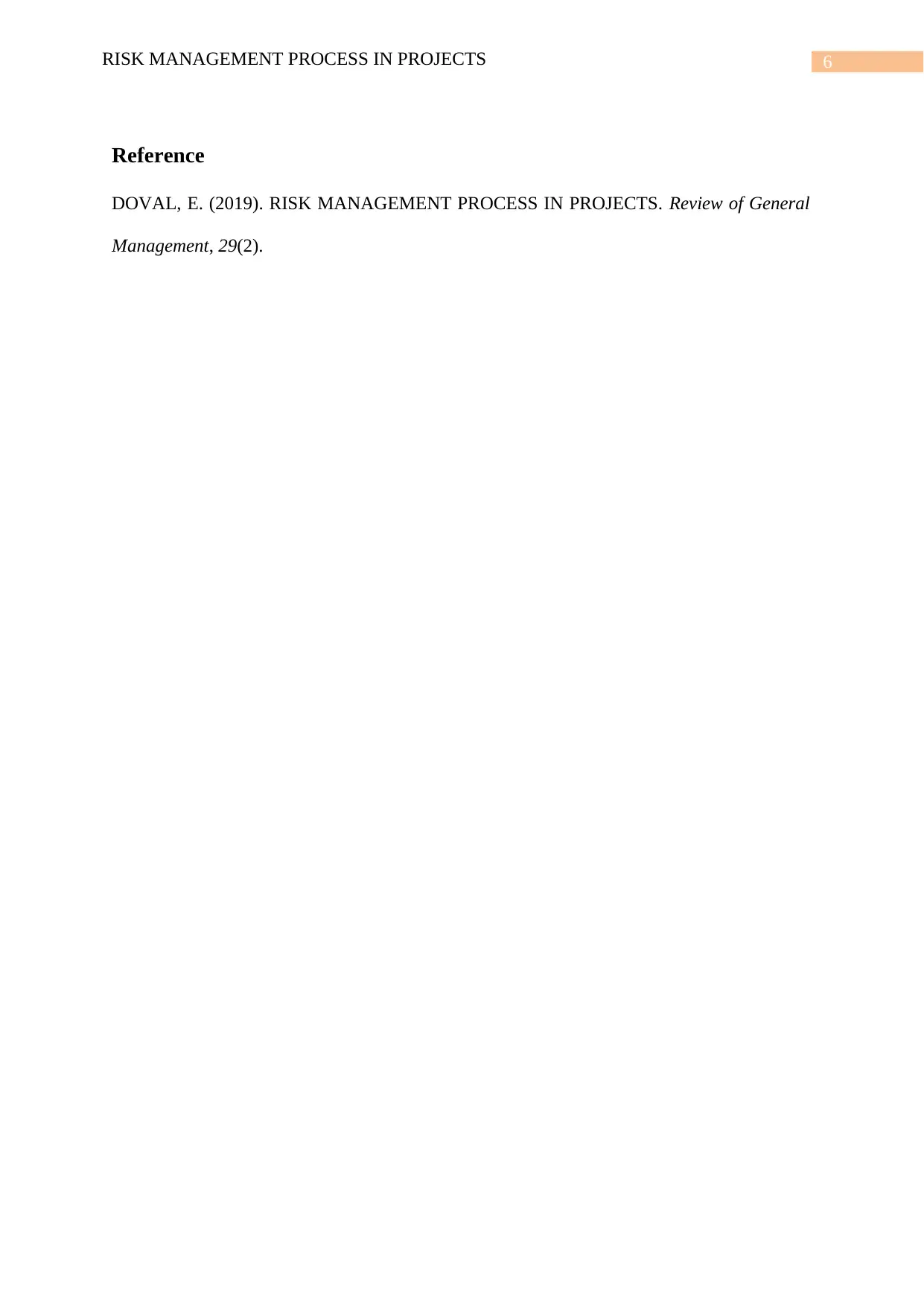
6RISK MANAGEMENT PROCESS IN PROJECTS
Reference
DOVAL, E. (2019). RISK MANAGEMENT PROCESS IN PROJECTS. Review of General
Management, 29(2).
Reference
DOVAL, E. (2019). RISK MANAGEMENT PROCESS IN PROJECTS. Review of General
Management, 29(2).
1 out of 7
Related Documents
Your All-in-One AI-Powered Toolkit for Academic Success.
+13062052269
info@desklib.com
Available 24*7 on WhatsApp / Email
![[object Object]](/_next/static/media/star-bottom.7253800d.svg)
Unlock your academic potential
Copyright © 2020–2025 A2Z Services. All Rights Reserved. Developed and managed by ZUCOL.





